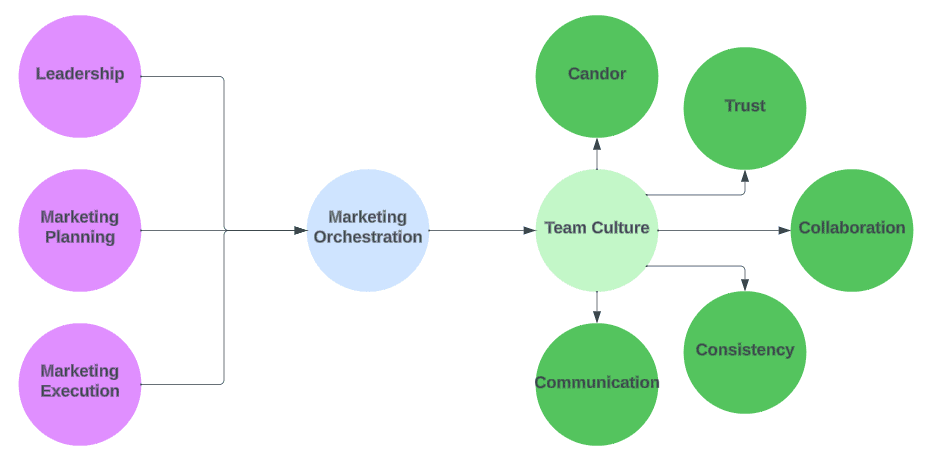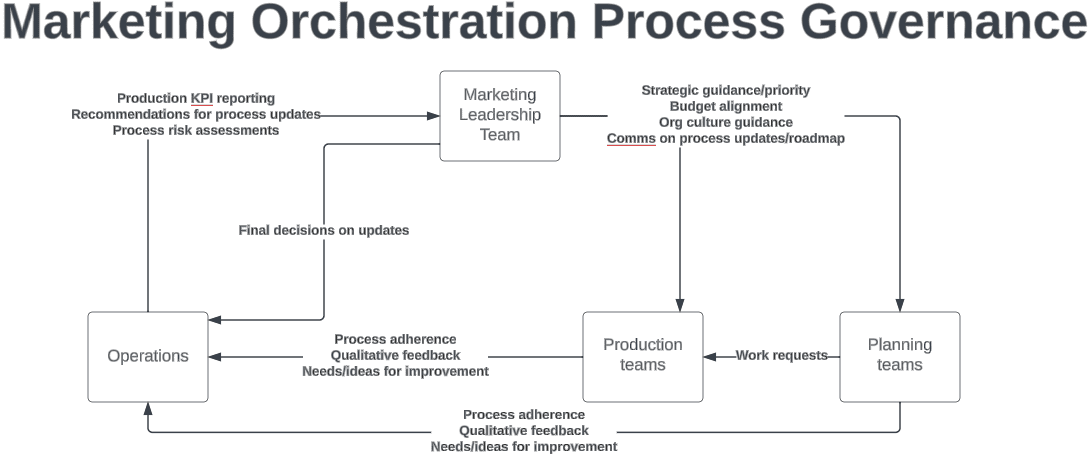Can Marketing Orchestration Improve Team Culture?

Summary
There are plenty of reasons to improve how you orchestrate your marketing. One that is often overlooked is how it can improve team culture. It takes work and focus to improve culture through orchestration, so this post should serve as a guide for how to build culture into your marketing orchestration governance and ensure that you are reinforcing the core values you want your team and culture to reflect.
By: Tom Swanson Engagement Manager at Heinz Marketing
Among leadership’s most important (and alliterated) duties is curating the company culture. While every leader I have spoken to has an idea for what they want this to look like, how they do it varies. The most effective method is positive feedback when folks live the values leaders want to promote. There are plenty of articles on what these methods look like.
We already know some of the benefits of marketing orchestration, such as talent retention and better alignment among marketing leadership. What I am writing about today is the most common challenge I hear when helping leaders curate culture:
I don’t have enough visibility to promptly reward when people demonstrate the cultural values. Even more dire: how can leaders avoid sending the wrong messages?
Sidney Yoshida wrote in 1989 that leadership has only a 4% awareness of the issues faced on the front line. This is likely improved thanks to technology, but the concept remains relevant. Effective marketing orchestration and the visibility it brings allows leadership to reinforce team culture.
Properly orchestrating your team is the best way to solve this challenge.
Let’s start with…
Who owns the culture?
Governance models are not something we talk enough about. Often overlooked, the governance model is very important for defining how a process is upheld, discussed, altered, and optimized. Teams will generally just assume that leadership is governing the process, but it should be defined.
Here is an example of a governance model we use as a template:

Notice the culture is defined as something leadership owns and disperses to the planning and production teams. This is often where marketing organizations run into difficulty: the interplay between leadership, planning, and production teams. If you have an in-house agency, this challenge is even more pronounced.
A good culture means a mutual respect and understanding between the two sides of the marketing coin. The two naturally put strain on one another as planning teams try to react to the market and production teams try to manage their capacity. Good marketing orchestration requires both needs to be balanced.
If things are out of whack, the culture suffers as a result. Trust gets damaged and takes a long time to build back. It should be made explicit that leadership monitors and manages this. By doing so, you are putting leadership in a position where it makes sense that they would need visibility into each step of the process and how the teams collaborate throughout.
Don’t sleep on governance.
Orchestration elements and culture
Every culture is different. The values you want to foster might vary, but a common one for all teams I have worked with is a collaborative culture, so I will use that as the example. If you want to foster siloes and work-hoarding, then this might be the wrong article for you. However, if you want to improve the areas listed in our free Marketing Orchestration Scorecard and build a culture that reduces collaboration drag, then read on.
In order to recognize when collaboration occurs and should be celebrated, you need 3 things set up.
1. A workflow with clearly defined steps
Small scrappy teams can collaborate willy-nilly, but large teams demand consistency. For meaningful collaboration to happen with any regularity, defining your workflow is table-stakes.
For any value, consistency of workflow will help ensure that teams are developing in a good direction.
2. The RACI must be defined.
You want people to own their work. Taking ownership is often held aloft by leaders as a desirable trait. While a wild-west RACI might give you a Darwinian view on who takes ownership, a structured one lets people shine in the role they signed up for. Clear expectations are a key part of the path to victory.
One note with the RACI is that while you want to be flexible, you must hold the boundaries here. If someone is accountable to a step, they must own that step. It is very easy to be lax about the boundaries of a RACI, but doing so damages the integrity of the tool and makes it untrustworthy. Once you allow even a single work-around, others will find a way in.
3. Finally, and probably most challenging, you need consistent touchpoints with your management team.
These meetings are your window. The workflow and RACI set up the expectations for how people should work, now the meetings are how you see it in action. Here are some things to look for in those meetings:
- Gratitude – look for managers expressing gratitude to each other. Foster this, make space for it. I like to do this explicitly in my meetings, but depending on your team, you might want to be more subtle about it.
- Candor – When working in a defined, clear process, you can expect greater candor from your managers. This should also be celebrated.
- Questions – How many times do you ask questions to be met with crickets? Asking questions is a sign of comfort.
A quick note on celebration.
Find ways to do this publicly. Culture is a shared pool, and when someone exemplifies it, they should be upheld. The rewards should be displayed so that others will strive to achieve them as well. Often times, positive feedback is given behind closed doors. Sometimes this is preferred, as many folks don’t want to be in the spotlight. When appropriate, it is good to celebrate cultural wins in front of the whole team.
I have found a good way to find the right times is to talk to the person I am giving the feedback to. Be open about why. If someone is driving meaningful collaboration, then say you want to make sure everyone sees how it should be done. However, since they are the ones doing the work, it should be their call in the end.
Putting it together
Once you have the pieces in place, managing the culture becomes considerably easier. Your best performers, both in terms of output and culture, will stand out. You will be more able to give positive reinforcement and improve the overall culture of the team.
So to recap.
- Build culture into your governance model, and have it be owned by leadership.
- Establish your workflow so you can start to see where people shine.
- Set clear expectations around ownership with a RACI.
- Get visibility into what is going on at the individual contributor level by setting consistent meetings with your managers.
- Celebrate the cultural wins visibly to inspire others to live the team values.
- Just make sure to do this appropriately and don’t put someone in an uncomfortable situation.
As always, I am here to help. Feel free to shoot me a message on LinkedIn or email if you want to chat. You can find me at tom@heinzmarketing.com.







